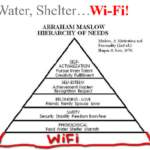Application and Website Analytics
Application and Website Analytics scour data around what websites people go to, what search terms they enter, what applications they use, what social media they engage in, for how long, if they buy something, and other relevant data and present it to the customer via user-friendly dashboards, notifications, reports, and or APIs that interface with 3rd party CRM, POS and advertising systems. This was originally designed for IT to be able to report on what websites and applications were being used on the network, Firewall them – block or allow, bandwidth allocate them, and prioritize them with QOS but has since taken a central role in assessing the on-line behavior of a user on premise.
One of the many applications for Applications and Website Analytics is quantifying and embracing showrooming. Showrooming is the practice by shoppers examining merchandise in your store without purchasing it, while shopping elsewhere online with a mobile device to find a lower price. Application and Website Analytics bring you wide visibility into this practice allowing you to quantify the impact by analyzing things like the products your customers browse online, the search terms they use, and the social media they engage in, and at the same time embrace it by redirecting shopper’s mid-surf and offering price matching, faster delivery and onsite fulfillment.
Social Media
Instead of people entering their email address, filling out a form, creating an account with yet another username and password to remember during the user journey, you could use Social Media login options such as Facebook, Twitter, Linkedin and Google to allow access to the Wi-Fi. Not only does this make for a great user experience for the end-user by allowing them to simply login with their Social Media channel credentials, the venue gets something in return. Not a direct exchange of money but they get likes/follows, posts tweets – social media exposure. More importantly they get access to a whole wealth of information such as email address, demographics, likes, interests, etc. allowing the venue to deliver targeted content, ads, services and offers like never before.
Conclusion
Gone are the times of offering Wi-Fi internet access paid for by the end-user with a direct exchange of money or providing free Wi-Fi access with the hopes the incremental loyalty will offset the lost revenue. Consumers are demanding always on anywhere wireless internet access and they are expecting it for free. They see Wi-Fi as just another utility, like water and electricity. They expect it there, they expect it free and they expect it just to work. Venue owners and service providers alike must find new and innovative ways to monetize the Wi-Fi without the direct exchange of money such as, providing premium tiers of access, leveraging user journeys and location-based services as a platform to deliver targeted content, leveraging analytics and 3rd Party CRM, POS and Advertising systems to provide that targeted content and finally leveraging social media channels as a new and exciting source of data to analyze.







Recent Comments